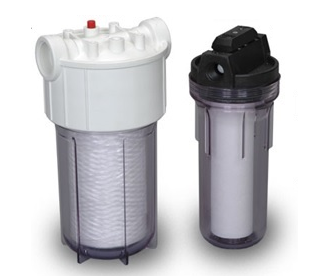
Your well can produce a lot of gunk! Sediment, mud, even sludgy iron bacteria.
One of the easiest and cost-effective ways to protect your home is by installing an In-Line Cartridge Filter. Also known as a Whole House Filter.
The Filter Unit is installed after your pressure tank (if you have one) and usually before any water treatment equipment. It can also is great for city water.
There Are 3 Parts to The Filter:
- The head (the top) – some have a valve built right into the head
- The housing or sump
- The disposable filter insert that gets changed every 2-3 months
The magic happens with the disposable filter insert which comes in many different styles and sizes.
How To Choose The Right Filter Unit
#1 – Choose the Filter Unit Size
Standard In-Line Cartridge Filter
- Recommended for water with light amounts of sand and sediment
- Holds filter inserts that are 10” long by 3 1/8” wide.
- Small size means easy to install, easy to change and cost effective
OR
Larger Big Blue/Bertha Cartridge Filter:
- Recommended for most water qualities
- Holds filter inserts that are roughly 10” long by 4 1/2” wide
- Extremely versatile, easy to install, easy to change and cost effective
- Filters last longer and catch more sediment before needing to be replaced
#2 – Choose What Filter Insert to Use
Quick Tip > How much sediment a filter can catch is measured in Microns – usually between 1 and 50 microns. The smaller the micron size, the smaller the particle it will trap and the quicker it will get clogged. Too large a micron size will allow sediment to pass through the filter, potentially clogging up. A 20 micron is a good place to start.
String and Pleated Filters for Sediment
- Comes in many different micron sizes
- 20 Micron is a good place to start
- A string filter looks like a ball of yarn has been wrapped around a paper towel.
- A pleated filter looks like accordioned paper, similar to the air filter in your car.
- Both work exactly the same way and catch the same size particle.
Dual Gradient Filters for Sediment
- It’s two filters in one
- Outer layer of the filter is a larger micron (typically 25)
- Inner core is a smaller micron size (typically 5 or 1).
- This allows small particles to pass through the outer layer but still collect inside the filter.
- The larger micron particles get trapped on the outside of the filter.
Carbon Filter for Odor
- If you have a slight sulfur smell to your water
- Have a chlorine taste/smell from city water
- Filter is impregnated with activated carbon dust that removes the smell and chlorine.
- Carbon filters are a must if you have a water softener on city water. Chlorine will damage the resin inside the softener.
- These filters tend to cost more due to the carbon and are rated around 10 microns.
Polyphosphate Filter to Add a Protective Coating to Your Copper Pipes
- Unique filter insert that protects against corrosive water
- Filled with a chemical that dissolves and forms a protective barrier inside plumbing.
- Use in water high in TDS (total dissolved solids) or corrosive
- Protects against pinhole leaks and brittle pipes
#3 – Decide How Often to Change Your Filter
Every well is different, and water quality can change depending on the time of year, weather, and water usage. H2O Equipment recommends replacing filters monthly as a good place to start.
Change your filter when you notice a decrease in water pressure, or (if applicable) your sulfur odor returns. Do not be concerned if your filter looks “dirty,” even if you just replaced it! You are seeing all the iron, sediment and muck that would otherwise end up in your plumbing, water treatment equipment, and fixtures.
